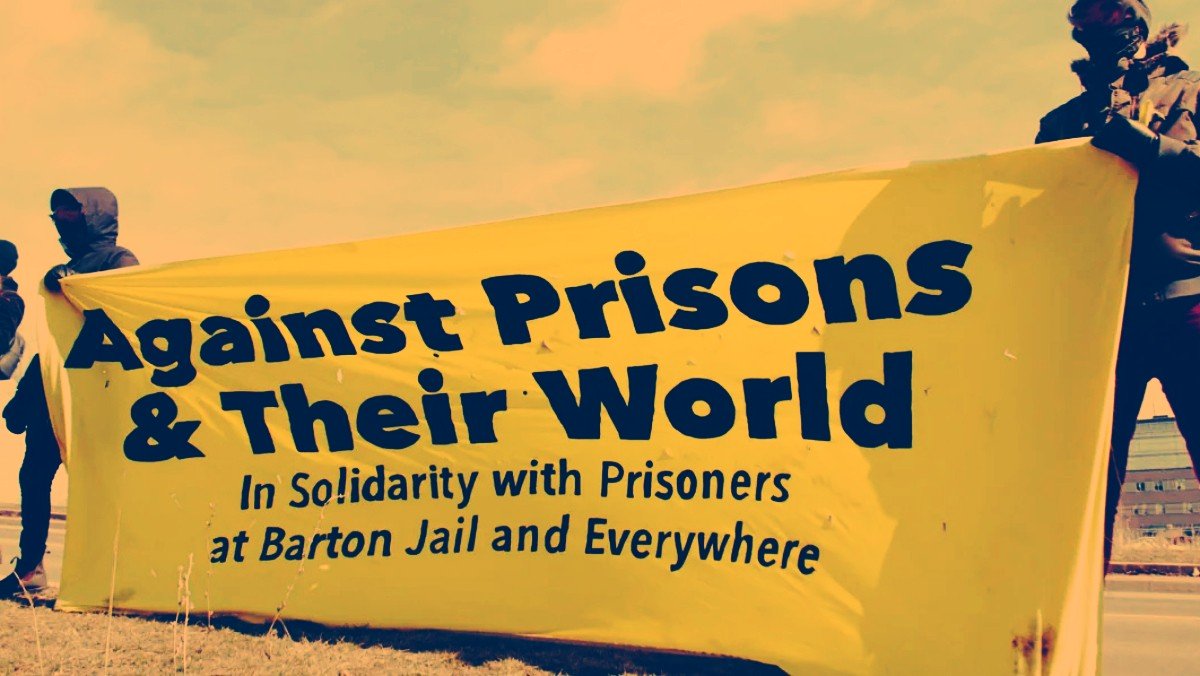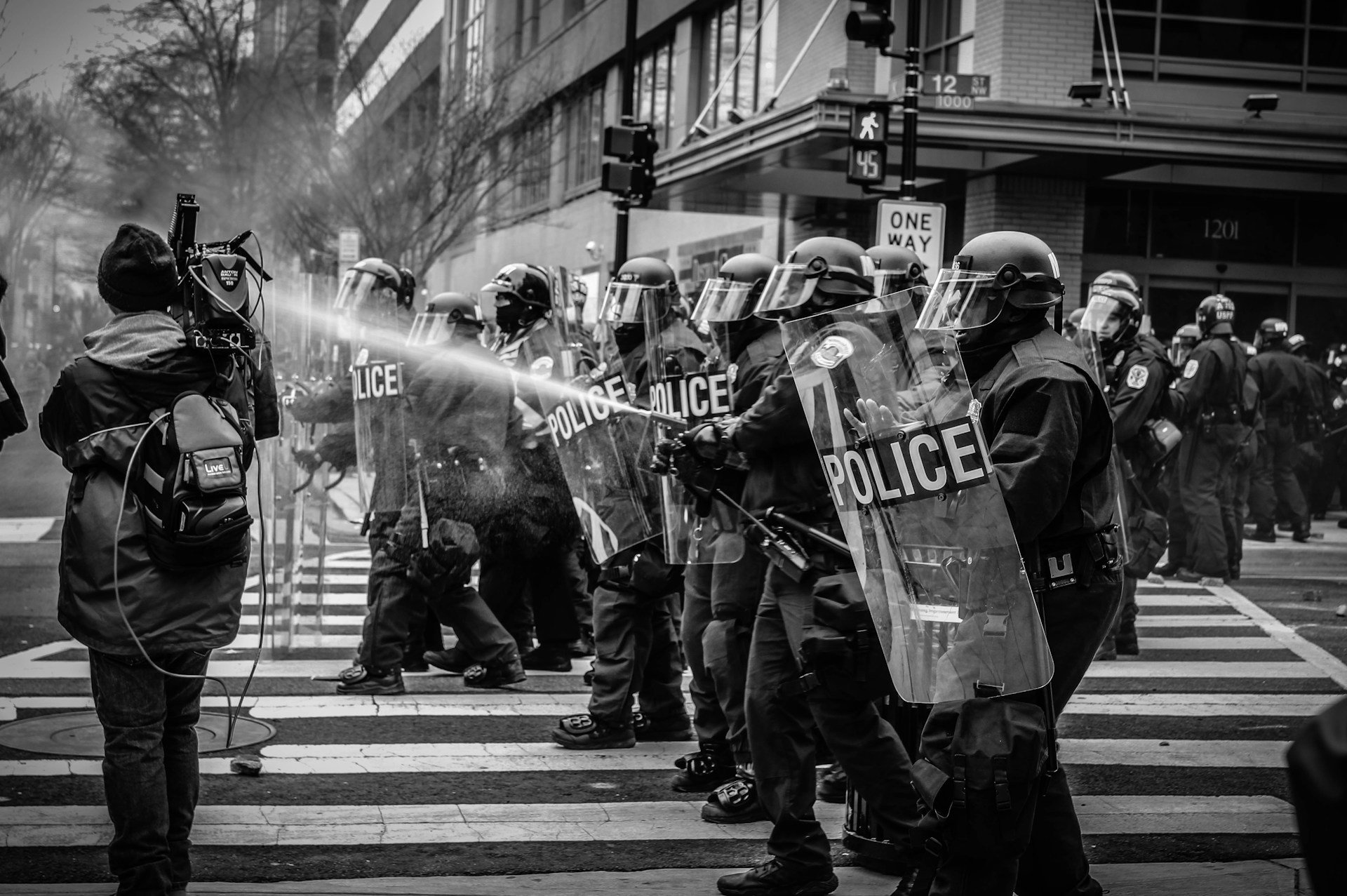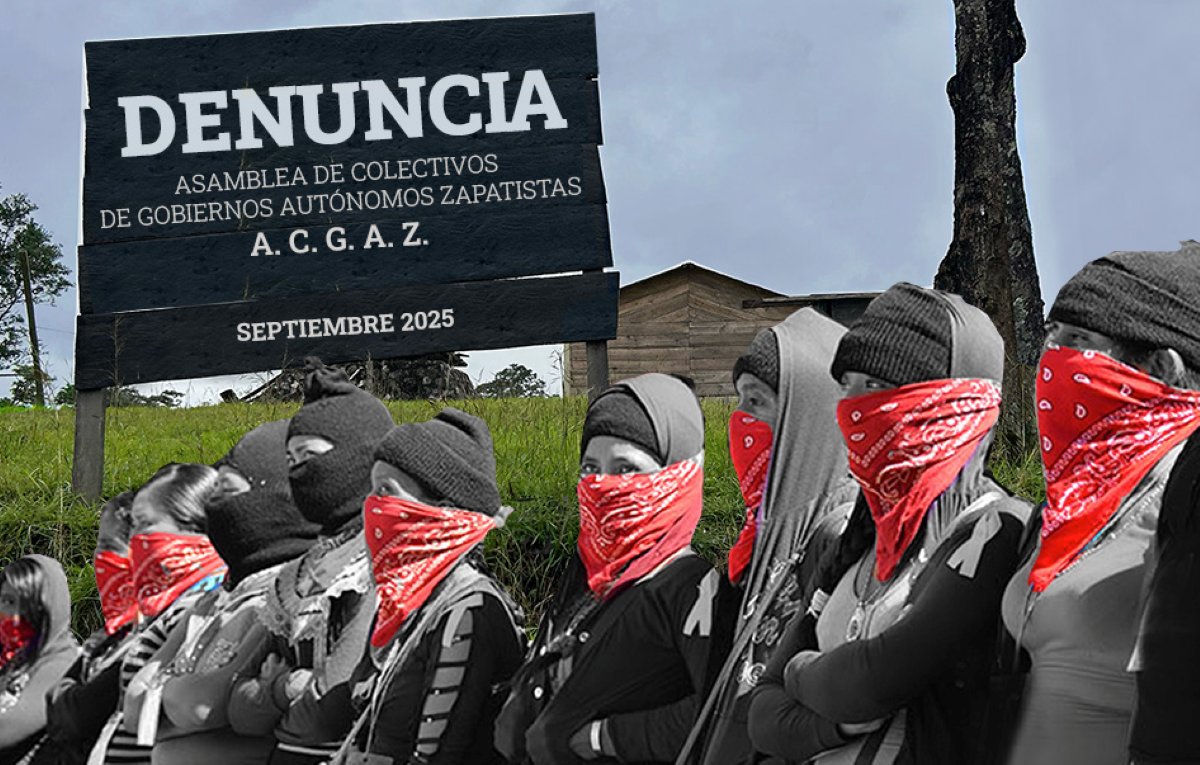In-depth reflection and analysis from the Barton Prisoner Solidarity Project (BAPSOP) on years of abolitionist organizing.
Download this Text as an Imposed Zine PDF
In the US and Canada, it doesn’t get that much lower than the prisoner. Excluded in every way, stripped of their most basic rights, exposed to humiliation and violence regularly, deprived of basic necessities, prisoners are at the very bottom of the social hierarchy, scorned and blamed by all the other classes. Prison crystalizes all forms of oppression and also props them up, and so organizing around prison can be a way of getting at the core of exploitative power relations in a community.
In Hamilton, our local prison is right in middle of the city, in between the cheap grocery store and the beer store. We pass it all the time, and it literally casts it shadow over us. Our goal in starting the Barton Prisoner Solidarity Project (or BAPSOP) in 2018 was to “thin the walls” and make it so we could hear the voices of our neighbours on the inside, make them feel a little less alone.
With this text, we want to explain some of the philosophy behind our group and make a case for a certain way of approaching prisoner solidarity organizing — and maybe even solidarity organizing in general.
What We Do
Our activities as a group include maintaining a phone line and PO box in order to be in touch with prisoners and both provide direct support and monitor conditions inside. We also keep up social media accounts and work with the mainstream media to share news about what is going on inside. We also occasionally hold rallies or other public events to put pressure on the prison.
These are simple activities, but they are powerful. Our goal is to change the balance of power inside the prison by supporting prisoner self-organizing. We do this by working with prisoners to identify issues and help them develop tactics for pressuring the institution. We also advocate around conditions, develop relationships, and do favours for prisoners, because we want our neighbours on the inside to feel respected and cared for when they come out, rather than like the shit on society’s boot.
3C range in the Barton Jail on hunger strike in #HamOnt as of this morning against degrading conditions and mismanagement of the outbreak. We went out with a banner to spread the word to other ranges.
Support rally this Saturday at 1pm on the Ferguson side! (1/2) pic.twitter.com/VUoC8kEYwh
— Barton Prisoner Solidarity Project (@ProjectBarton) March 3, 2021
There are some things that we don’t do. We don’t do long-term case work, following prisoners through their process, trying to get them better outcomes in the courts, or providing support when they get out. We do random favours, like helping with a three-way call or sending a few texts or finding a lawyer, but we don’t go much further than that. We don’t give anyone money or legal advice. We don’t do popular education for non-prisoners, and we aren’t trying to grow as an organization. BAPSOP is a closed collective doing some specific work, and we intend for it to stay small and focused. Other prisoner solidarity groups have struggled to keep going because the level of need is so high that they take on many different kinds of work and burn out — by being clear about what we do and don’t do, we hope to make our project more sustainable.
Philosophy
There are other groups that do prisoner solidarity work, but our philosophy makes BAPSOP different.
A big piece of that is political clarity — we are anarchists and we are always fully against prison. Folks on the inside know who we are and what we stand for, which is part of not just being another service organization. We get into the details of what goes on inside the prison (like, we know if laundry came on the day it’s supposed to and which sergeants are on duty), but we are here because we want to destroy the institution.
The reason we don’t do outreach work and don’t seek new members is that the site of struggle is the range. Our goal is to shift the balance of power between prisoners and the institution that oppresses them. If we win, we win on the range. We are not trying to create change by pressuring the government, changing people’s opinions, getting more funding for programs, or anything like that. We want change to happen because the administration is forced to reckon with an organized body of prisoners and supporters that is capable of pushing back on their authority.
4:30pm this Wednesday, Dec 2nd! Staff at the Barton Jail in #hamont have been testing positive for covid and the admin are trying to cover it up. Let's show prisoners they are not alone!
Start on the west side in car or on foot, wear a mask, don't "gather" pic.twitter.com/itpAGsKnLU
— Barton Prisoner Solidarity Project (@ProjectBarton) November 30, 2020
Struggle is constant — wherever there is oppression, there is resistance, and people tend to resist spontaneously at the site where authority is exercised over them. In prison, that site is the orders from the guards and the rhythm of the day. When we set out to support prisoner struggle, we look at the ways resistance is already occurring organically and ask how can we encourage it to deepen and spread.
It is not enough for people doing prisoner solidarity to simply repeat the demands from inside. We believe that people on the inside and on the outside have different goals and roles. This is a way of dealing with the tension around demands related to reform versus abolition.
We are against prison and against reforming prison, and we also make specific demands based on what prisoners are asking for. However, demands are slippery — the nature of a demand changes when it travels from the inside to the outside. Inside, a small demand can become explosive, with no limit to how much it can escalate. It is no exaggeration to say that people have died over an early lockup. But on the outside, that same demand is just a mild policy disagreement, and we would just be reformists dialoguing with power if all we did was repeat it.
To resolve this tension, we need to understand what our role is as people in solidarity and therefore what our goals are. The role of prisoners is to win concrete struggles and build their power; the role of people on the outside is to destroy prison. We support them to win inside, but we don’t make their demands our own — we stay focused on destroying prison brick by brick while also calling on the admin to negotiate with prisoners to meet their demands.
What Organizing Looks Like
In the four years our group has been around, one of the main forms prisoner struggle has taken is the hunger strike, and here we are going to walk you through the process of how a typical hunger strike happens.
First though, hunger striking as a tactic is not well understood. The prison system is used to hunger strikes, and an individual doing it to try to produce a crisis by affecting their own health is unlikely to succeed. The prison treats it as no different than other forms of self-harm and has policies and procedures in place to funnel you into the medical system. Collective hunger strikes are different — rather than trying to create a health crisis, they create a crisis of mass disobedience and refusal.
As the pandemic surges and lock-down measures loom large, we wanted to offer an update. Our phone line has slowed down in recent months, but we're still in regular contact with a few prisoners on different floors of the jail.
for more visit:https://t.co/3bNqhER1hz pic.twitter.com/YblzxWEIWV— Barton Prisoner Solidarity Project (@ProjectBarton) November 18, 2020
Prison tries hard to get prisoners to participate in their own incarceration. You have to participate in programs, talk to a psychologist, cooperate with guards, take on prison jobs, and follow all orders in order to receive privileges within the system. Without the participation of prisoners, the fundamental violence of the prison system is laid bare and the prison is left with no choice but to govern by force.
In a hunger strike, prisoners are refusing to take their meals, one of the most basic acts of participation they are invited to engage in. Typically, prisoners would also refuse to have their strike medicalized by not cooperating with the daily medical exams the prison tries to force on you when you are refusing meals, which further throws a wrench into the prison’s procedures.
Here is how it often goes down:
- First, we establish contact, usually by phone. We write our number on a banner and hangout around the prison where people can see us.
- We get calls, we listen, we take detailed notes
- We build relationships on as many ranges as possible and try to get people calling us regularly to keep us posted about conditions.
- Once we have some relationships, we try to identify organic organizers, the people who are already talking to folks on their range about collective problems. We also try to cultivate organizers by encouraging people to take their complaints about conditions to other people on their range and get on the same page about what is wrong.
- We then compare notes across different ranges, telling people who call us about the problems elsewhere in the prison. This gives us and the inside organizers an overall picture of conditions in the prison.
- We support prisoners in creating lists of demands and building support for the list on their range. This is done in one of two ways: either through an assembly, where the TV is turned off and everyone on the range discusses together, or quietly, where the demands are circulated in one-on-one conversations and the written list grows and evolves.
- Demands have included: an end to lockdowns, access to books sent from outside, daily yard time, faster mail, access to hygene supplies, visits, additional canteen items or the ability to hold more money, and more
- We communicate the list of demands to other ranges and get buy-in so that multiple ranges are asking for the same thing. This often involves things being added to the list, which involves more conversations on the ranges that already agreed to it.
- We discuss possible tactics. Here, we are careful not to push people towards any particular tactic. We try to let it emerge from what struggle already looks like inside and from the history of struggles that prisoners are aware of.
- There have been actions that aren’t hunger strikes (like ranges refusing lockdown or refusing to return their meal trays or vandalizing phones or assaulting guards), and we try to be clear that we are in solidarity with any form that resistance takes. We do try to emphasize that things are stronger when they are more collective, which often involves them being planned in advance.
- Prisoners in Ontario’s provincial prisons do not have access to work and don’t really have any programs, so the range of tactics available to them is pretty limited.
- When prisoners choose to hunger strike, they can begin building a strike fund by stockpiling food.
- Since the goal is not to create a crisis by ruining your own health, it is not necessary to completely abstain from food. The important thing is to refuse the prison’s food — to refuse to cooperate with their feeding responsibilities. This means that with some planning, ranges can save up food, either off their trays or from canteen purchases, in order to keep more people on strike longer. The strike fund is held in common by trusted organizers and is distributed over the course of the strike.
- Prisoners pick dates for the strike
- We try to be clear about what we will do on the outside: we will talk to other ranges and be out with a banner at 9am on the day the strike starts to announce it, we will do social media and send out a press release, we will hold demos and do a phone zap, we will release statements and letters from people inside…
- Making regular social media updates about conditions in prison is an important part of our work, and it allows for some dialogue with the friends and families of prisoners. It also means we then have some ability to reach people and mobilize if need be. The mainstream media is also super important, since prisoners in Barton have access to the local paper and all watch the local evening news. Having a good relationship with journalists looks like having a media spokesperson in BAPSOP and also arranging interviews with prisoners or writing press releases. Relying on these institutions is obviously a problem, but it has been important in our work.
- Prisoners would then refuse trays and also refuse medical exams, because it is a political issue and not a medical one. They would make their demands known, sometimes by sending a letter to the superintendent through the guards. And they would engage in negotiations with higher ups, either all together or in a small group.
- Typically, the strike ends when the admin makes concessions or offers a promise of change. But often these would be only partially implemented or would prove temporary, and so the cycle would repeat.
Each time the cycle repeated, the actions took less work and were stronger. During the COVID-19 pandemic, there were three or four rounds of strikes, culminating in one involving over 200 prisoners, almost half the population of the prison. This coincided with a COVID outbreak, when conditions in the jail were really at their worst — a lot of the demands were about getting “back to normal,” with visits, time out of cells, yard time, things like that. But in addition to winning these (sometimes more than once), prisoners also made some other gains and got items added to cantine (Mr Noodle cups!), some extra TV channels, and an overhaul of the library, significantly improving access to books.
Things have been a bit quieter since then, in large part due to mass transfers related to some construction work in the prison (these transfers seemed to target politicized prisoners, unsurprisingly). However, transfers have also been a vector for spreading discontent. For instance, one prisoner who had gotten politicized in Burnside prison in Nova Scotia worked on organizing his range in Barton before being transferred to Maplehurst (about an hour away) where he continued that work. Another prisoner was transferred from OCDC in Ottawa and found the conditions in Barton to be so much worse that even just telling other prisoners about the difference was enough to trigger a wave of organizing. Prisoners also heard lists of demands being used by prisoners in other institutions through the mainstream media, which motivated them to develop demands of their own.
Hard Stuff
There are a lot of challenges in this work that we don’t always have great answers to, and we thought we would share a few of them here. Our hope is that other people will bring their own twist to this work and come up with great solutions to things we struggled with.
We had a hard time cultivating organizers and keeping track of people. Since we don’t have control over when we are in contact with prisoners, we were dependent on them deciding to call us and couldn’t do anything if they didn’t. That meant we often didn’t know if people had been transferred or sent to seg — we just stopped hearing from them, which also sometimes happened because folks just didn’t feel like calling for a bit. As a result, organizers were taking some significant risks and, if they experienced reprisals, we wouldn’t know and so were slow responding to support them.
Similarly, the very local nature of our project was both a strength and weakness. By focusing on one facility, we could be very reliable and also have a very thorough knowledge of conditions, but it also meant that we couldn’t do much if people were transferred. This was tied to our phone plan, which made it expensive (or sometimes impossible) to receive calls from any other prison. Some groups have tried to respond to this by operating multiple phone lines for different facilities, but we have so far not done this. We do occasionally respond to calls we get from other places, especially if prisoners are reaching out to tell us they are taking action (our number really got around), but we are not able to be reliable around this.
Our closed collective model had some challenges, but it was also a strength, since it allowed us to move quickly and be nimble in responding to events, and also to develop a really good group dynamic among a handful of highly motivated people (never more than 6). But it also meant that replacing people when they left was really hard, which led to us taking a six month hiatus at one point after the phone line had been run by just two people for about a year (which is a 12 hours a day commitment, seven days a week).
Collective Action For The Win! Hunger Strike in Barton Quickly Forces Concessions from the Admin
Today at noon, we learned that four ranges on the Barton Jail's fourth floor had resumed a hunger strike, with at least 60 prisoners confirmed to be participating . pic.twitter.com/udLNWlBxIz
— Barton Prisoner Solidarity Project (@ProjectBarton) July 28, 2020
The high cost of the phone line and the PO box have been a challenge at times, since the costs stay about the same every month but our ability to raise money is mostly limited to times when there is an exciting action happening. This got worse as people were transferred, since we tried to stay in touch with them, but ended up on the hook for hundreds of dollars in long distance fees. We responded to this by giving out our personal phone numbers to people who got transferred who we wanted to stay in touch with, but this has the effect of transferring costs to the prisoners and it also creates problems in terms of safety and privacy (you probably don’t want your personal phone number floating around a prison with a reputation for being a friendly girl).
And as always, recuperation is never far from our minds. A lot of the demands made by prisoners are shared by the system itself — the prison system also wants less overcrowding, more programming, supports for mental health and addiction, regular schedules around range and yard time, and so on. One of the main ways the prison system reforms itself is by physically expanding, building new prisons. Some of our members have tried to respond to this by starting another project specifically opposing prison expansion, which you can learn more about here: escapingtomorrowscages.org. We have been more successful in avoiding recuperation than some other prisoner support projects, who have continued advocating for specific facilities for people with mental illnesses at the same time as the province is announcing it is building new prisons specifically for such people. But we can always do better.
To Conclude
It’s not that prisoners are a revolutionary class, but there are unique opportunities in and around prison. Prison is a factory for reproducing subordinate roles within dominant power relationships by creating trauma and exclusion. When we do the work to elevate the voices of people on the inside, we can help interrupt that cycle.
In a small way, we have seen the Barton Jail become a site of politicization and empowerment, making marginalized people feel strong and supported. We can lift each other up, and the struggles for basic human dignity underway inside do make us all more free on the outside.
We in BAPSOP are no different than the people on the other end of the phone — we too risk prison through the lives we lead, and and we too live in its shadow. We see ourselves as personally invested in ending the prison system, even as our motivations are also ethical and strategic. Understanding this makes it easier to step into your role in the struggle against prison on the outside — to be independently invested in fighting and winning, rather than just being a supporter.
We would love to hear your reflections and experiences. If you do prisoner solidarity work or are interested in starting, you should definitely get in touch with us at bartonsolidarityproject@riseup.net.
Further Reading
For more on the idea that struggle is constant, we were inspired by workers’ inquiry from the sixties and seventies in Italy, where the phrase used was lotta continua. You can check out the great book The Golden Horde by Nanni Balestrini and Primo Moroni, especially the end of chapter 5 and the start of chapter 6.
For more on participation and refusal, see Locked Up, by Alfredo Bonnano
For more on how rebels on the inside and on the outside have different goals and roles and about how to resist recuperation, see A Crime Called Freedom, by Os Cangaceiros
For more on how the prison system in Canada has evolved over the last thirty years, see Taking the Rap: Women Doing Time for Society’s Crimes, by Ann Hansen
For a summary of recent hunger strikes in Canada, including the ones in Barton, see Chip Away at It: A Year of Covid-Era Hunger Strikes in Canada’s Prisons, by MJ Adams






